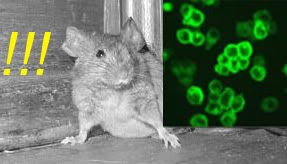
Researchers at the University of Michigan have developed a way to smuggle strong anti-cancer medicine into the center of cancer cells, leaving healthy cells unphased. For the experiment, the researchers used mice which had been engineered with human epithelial cell tumors on their backs, and injected a special concoction of the anti-cancer drug methotrexate, folic acid, and a fluorescent imaging agent all wrapped up within a specially designed nano-particle called a dendrimer.
"The technique employs cunning Trojan horse trickery. All living cells require folic acid to replicate, but cancer cells have a particularly strong appetite for it, displaying up to one thousand more docking sites - called folate receptors - on their membranes. By attaching five folic acid molecules to branches of the dendrimer, the researchers were able to lure the cancer cells into accepting the whole package across the membrane and into the cell - including the toxic drug, which then kills off the cell."
While traditional chemotherapy applies high concentrations of anti-cancer medicine to the affected areas, it also damages living cells in the surrounding tissue. This new technique is the first developed that allows the normally toxic medicine to actively seek out cancer cells, while leaving healthy cells unphased. The medicine, while not curing cancer completely, may one day dethrone cancer as a killer, transforming it instead into a chronic, treatable disease.
In the longest trial of the medicine, ranging over 99 days, 30-40% of the mice given the nano-particle methotrexate survived, while all of those receiving free methotrexate died, either from the toxic effects of the drug or from the cancer itself. In the mice trials, the researchers were effectively able to reach a 30-day delay in tumor growth, which is equivalent to about 3 full years for a person.
The group is hoping to begin drug trials in humans within 18 months, although producing the nano-drug will be a costly and technically difficult process.
source article at newscientist


No comments:
Post a Comment